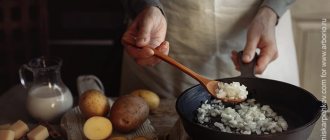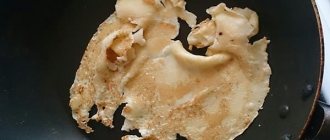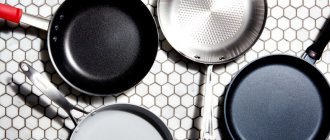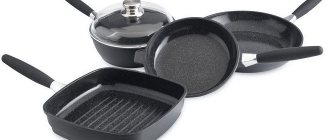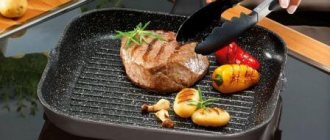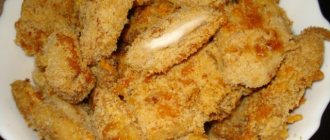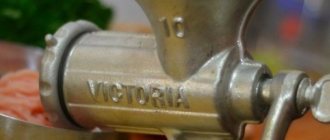It often happens that a favorite frying pan, in which more than one dish has been cooked, suddenly begins to spoil the food. To prevent food from sticking, there are several ways to restore kitchen utensils to their former properties and prevent further food burning. All restoration methods do not require the use of hard-to-find materials and can be easily applied at home.
Which pans are the least likely to cause food to burn?
Without a doubt, the leader in this rating is a frying pan with a special protective non-stick coating. But don’t be mistaken about the fact that you can cook with it without oil. It is necessary, only much less is required. A drop is enough. An additional advantage: you do not need to closely monitor the heating process.
At the end of the list are frying pans that have a porous surface. For example, cast iron. It requires a large amount of oil for coating and frying, so that it forms a layer that protects against the formation of burning.
The most difficult case is steel cookware. Metal is finicky: it heats up unevenly and quickly, requiring more oil and thorough heating.
Service life of pans
| Material from which the frying pan is made | Life time |
| Cast iron | Decades |
| Stainless steel | Up to 6-10 years |
| Ceramics | From 3 to 5 years |
| Aluminum | From 3 to 8-10 years |
| Non-stick coating | From 3 to 10 years (depending on texture) |
| Enameled | Becomes unusable after any damage |
If only the middle burns
The phenomenon in which burns form only in the middle is associated with heating devices. This problem most often occurs among those who use gas burners. The heat is distributed unevenly along the bottom, and the greatest heat occurs in the center of the pan. The heat from the flame does not dissipate and is directed directly. With large cookware, the food in the middle cooks much faster during the cooking process, which contributes to the formation of soot. You can solve the problem by purchasing a frying pan with a smaller diameter. It is also effective to use a special device that cuts through the fire and distributes heat over the entire bottom area.
Grill pan
A grill is a frying pan that has a grooved bottom. Thanks to the uneven surface structure, the meat is fried so that it retains its juiciness, and at the same time has a crispy crust. If such a frying pan is burnt, what should you do? Care depends on the metal:
- If the cookware is made of cast iron or aluminum, then it must be calcined with oil or salt.
- The enamel container is rubbed with oil, fat, lard, but there is no need to heat it.
- Teflon, ceramics and other non-stick coatings must not be heated or cleaned with abrasives. If such a frying pan begins to stick, what should you do in this case? It will not be possible to clean it completely; it is better to replace the dishes.
It is necessary to choose quality cookware. Also, do not forget about the rules for using frying pans. If you use proven cleaning products, you will be able to preserve the appearance of the dishes and also use them for a very long time.
Cleaning outside
Cleaning the outside is much easier; there is no need to avoid chemicals. It is recommended to use a cream or gel to clean carbon deposits. They corrode fat and carbon deposits, so dirt can be easily washed off with a sponge. However, any method listed above will help in the same way if you boil it in a basin.
It is recommended to use a cream or gel to clean carbon deposits.
Cleaning
If a ceramic frying pan is burnt, what should you do? If the dishes are still damaged, you need to do the following:
- The pan needs to be washed.
- Then it is dried.
- The surface should be rubbed with vegetable oil.
- The impregnation should be left for several days.
- Then you need to wash off the remaining oil with warm soapy water.
This completes the procedure for cleaning the ceramic surface. Proper care of your cookware will extend its service life.
If the enamel frying pan starts to burn
Such dishes require delicate handling; they should not be heated, as this will completely damage the coating. But if you begin to notice that pancakes or other food have begun to stick to the bottom, do not rush to throw away such a frying pan. Use the following method:
- Clean the bottom of the cookware thoroughly with detergent.
- Dry the surface, removing moisture with a kitchen towel.
- Rub the pan generously with any fat or lard.
It is advisable to carry out this procedure every time before you start cooking on this cookware. In this case, you need to fry by adding a large amount of oil.
Selection of products for cooking in stainless steel
To fry in such a container, use meat or vegetables at room temperature. Partially frozen ones or those just taken from the refrigerator will end up burnt without any options. Additionally, not every ingredient is compatible with stainless metal:
- use sunflower oil. Refined olive and sunflower oils have a high boiling point. By using them, you will protect the bottom from burning food, and yourself from toxic aldehydes;
- fry juicy foods. In a shiny steel frying pan, ingredients saturated with water are better cooked: tomato sauce, vegetable stew, fried fruit, fillet of juicy fish such as salmon;
- do not use more than three types of food. A wide variety of ingredients always causes burning. Some of them warm up faster, others slower, the temperature difference cools the oil, it begins to “stick” to the bottom. The optimal amount of edible components is two or three types.
Stainless steel cookware lasts longer than utensils made from other materials. It is good because it does not interact with acid and does not affect the taste of meat or vegetables. Dishes skillfully prepared in a steel frying pan have an appetizing crust that can never be achieved on Teflon. In the end, the shiny bottom cools down much more slowly, and dinner “arrives” after cooking and remains warm longer. To prevent food from sticking to the bottom during frying, use our tips.
Why does she stick...
A disclaimer needs to be made at the outset: not all pans are created equal. Modern frying pans with a non-stick coating, for example, are completely unheard of about the problem of sticking, because they were invented precisely for this purpose - so that you could fry cutlets, scrambled eggs and fish without thinking about how to finally tear them off the bottom of the pan.
Cast iron frying pans are a different matter: they are calcined in a special way with the addition of oil, which fills the microscopic pores in the metal, forming a smooth coating to which, if done correctly, food no longer sticks. Thus, the main record holders for food sticking are stainless steel frying pans.
A steel frying pan is a great item. It is grippy, not too heavy, its material does not react with acidic foods (as, for example, copper does), it heats up relatively quickly, and with the right skill, absolutely any dish on it will turn out absolutely perfect. A stainless steel frying pan, however, does not always heat up evenly, but this problem has already been solved by making multilayer frying pans with the addition of various alloys. Thus, its only drawback remains excessive stickiness.
So why does food stick to the pan?
This is where chemistry (in the science sense, not the science that everyone thinks) comes into play. You may not have studied or have completely forgotten what van der Waals forces are, but you are sure to remember that high temperature accelerates all chemical processes occurring around us. The cutlet might stick to a cold frying pan (if they both survived long enough), but in a hot frying pan this happens almost instantly.
Quite strong bonds are formed between the molecules on the surfaces of the food and the frying pan, whack - and your cutlet stays on as if glued! Products with a high protein content stick especially tightly to the pan, since proteins form compounds with iron atoms on the surface of the pan, and due to the structural features of fish in general and its protein structure in particular, it is fish that sticks to the pan most strongly.
Why did food start sticking to the pan?
In the old days, when there were no non-stick coatings, they used aluminum, cast iron, and steel frying pans. Their surface is porous and, when heated, the molecules easily come into contact with microparticles of food. As time passed, the sticking problem partially disappeared because the “pores” became clogged, but some foods still burned.
Modern cookware with various coatings has a smooth surface, eliminating contact between food molecules and metal. But over time, “sticking” will also begin on it due to a change in the quality of the protective layer: it ages, wears out, and becomes thinner. If “sticking” is observed on a new surface, this indicates its low quality and violations in manufacturing technology.
Other reasons:
- use of aggressive chemical cleaning agents and harsh abrasives;
- food residues, fat due to poor washing;
- damage from metal objects (knife, brush, spatula);
- improper use - maximum heating without food, oil, frequent overheating, temperature changes, when cold water is immediately poured after heating.
What can I do to prevent the pan from burning?
If food sticks to the pan, do not immediately throw away the pan. There are several ways to get rid of this problem and prevent it from occurring in the future.
Cast iron frying pan burns
To prevent food from sticking to the surface of the cookware, which was made from an alloy of iron and carbon, it is necessary to restore its natural non-stick layer. To do this, you will need to clean the surface of the kitchen product with detergent and then dry it. A natural or forced drying process is allowed, i.e., place the dishes on the stove and wait until the moisture has completely evaporated. You can't overheat.
When the dishes are completely dry, cover the bottom with a layer of salt (1-2 cm) and place on the fire. It is necessary to heat the metal for about 5 minutes. When the salt begins to crackle and change color, remove the cast iron product from the heat. You should not keep the dishes on the stove for a long time. When the pan has cooled down on its own, you can remove the salt, wipe the bottom with a paper towel (soft cloth) and wipe the surface with refined oil.
If you know how to properly heat and store a frying pan, you can restore even the oldest utensils. Cast iron products do not like high humidity. They also require constant care. The calcination procedure is recommended to be done after 30-35 times of using the kitchen appliance.
Uncoated aluminum frying pan burns
Microparticles of food penetrate into the porous structure of aluminum if the dishes are without an additional protective coating, and therefore the food begins to burn. It is recommended to restore such a surface using vegetable oil. Pour it so that it covers the entire bottom and add 2 tbsp. salt. The dishes are placed on the stove and the heat is turned on low. When a slight smoke begins to appear on the surface, remove the pan from the stove. After cooling, the contents are removed and rinsed with water. Detergent must not be used.
When a frying pan burns, a thorough inspection of its surface can tell you what to do. If there are deep scratches on the walls, you can try frying bread in it. Cut pieces of baked goods are laid out on a dry bottom (without adding oil or fat) and kept on fire until completely dry. When a golden brown crust begins to form on the bread, remove the pan from the stove and wait until it cools completely, and then wipe it with a paper towel. Additionally, you can grease the bottom.
Ceramic frying pan burns
Ceramic dishes can be restored with oil. It is cleaned of burnt food with detergent, wiped with a soft towel (you can dry it on the stove), and then treat the surface with oil or a piece of lard. After 15 minutes, I remove excess fat with a napkin.
If this method does not help eliminate the defect, there is no need to rush to get rid of the ceramic dishes. It can be used to prepare stews (provided the container is deep).
Stainless steel pan burns
Burnt food in a stainless steel frying pan must be washed off. To do this, you can try soaking the dishes in a soapy solution and then carefully remove the dirt. If you neglect to keep your stainless steel frying pan clean, the food on it will always burn.
After removing the contamination, pour table vinegar and water (1:3) into the frying pan and put on fire. The solution should be boiled for 15 minutes and then drained. After cooling, rinse the dishes with running water without detergent. Before cooking, pour peanut oil into the bottom and heat the pan for 5 minutes.
Non-stick frying pan burns
Cookware with non-stick coating has a shelf life, which is determined and indicated by the manufacturer on the packaging. This fact should be taken into account when purchasing, and not hope that the kitchen product will last forever. All attempts to restore the non-stick coating are useless. Therefore, if food begins to stick, the utensils must be replaced. Non-stick pans cannot be repaired.
How to fry without food sticking?
Food may stick due to uneven heating of the bottom. To prevent burning during frying, use a flame spreader (gas stove) or use a pan whose bottom matches the size of the heating surface.
To cook different dishes, you need to choose different temperatures. Meat is fried over high heat, and for vegetables and seafood - medium or low heat.
To prevent food from burning, food should be placed on a hot bottom. If you are using cookware without a non-stick coating, then before frying you need to wait until not only the surface of the pan, but also the oil (fat) heats up.
Food will stop sticking and burning if it is at room temperature. It is not recommended to fry foods that have just been taken out of the refrigerator.
Little tricks to prevent burning
- Only stainless steel pans can be washed in the dishwasher. All other types of kitchen utensils must be cared for by hand. Using a dishwasher increases the risk of surface damage, which can cause food to burn.
- It's not just non-stick frying pans that are susceptible to scratches. To extend the life of the product, avoid metal sponges and rough abrasives. You can remove burnt food by soaking the dishes. When cooking, do not use metal spatulas or spoons, as they will also scratch the surface. Preference should be given to silicone or wooden kitchen appliances.
- Before using a Teflon or other frying pan with a non-stick coating for the first time, it is recommended to pour water into the pan (to the brim) and put it on fire. When the liquid boils, reduce the flame and leave on the fire for 10 minutes. After the time has passed, the water is poured out and the surface of the frying pan is treated with a small amount of vegetable oil.
- Ceramic utensils require constant care. To extend its service life, it is recommended to always lubricate the surface with vegetable or olive oil after washing.
- A high-quality stainless steel frying pan begins to burn only if it is not properly cared for, if not enough oil is poured during frying, or if a lot of food is placed on the bottom. Water can cause sticking. For this reason, before placing food on a stainless frying pan, it is recommended to blot it with a paper towel.
- After use, the dishes must be cleaned of dirt. Dry pans before storing them in the cupboard. Additionally, the surface can be lubricated with olive oil. Do not store pans on top of each other, as this increases the risk of damage.
- If foods will be fried in natural butter, it is not recommended to overheat it. Otherwise it will start to burn. If the food does not stick, the taste of burnt butter will spoil the dish.
- To extend the life of a frying pan that is made with a non-stick coating, do not wash it immediately after cooking food. It is recommended to wait until it cools completely before starting to remove dirt. It’s also not a good idea to pour cold water into a hot frying pan. Splashes resulting from contact between grease and cold water can cause burns. In addition, sudden temperature changes have a destructive effect on the non-stick coating. Cracks and chips will begin to appear on it.
- You can prevent food from burning on an aluminum frying pan using apple cider vinegar. There is no need to worry that the acid will affect the taste. After pouring oil into the bowl, add 1-2 tsp. vinegar. Cooking begins when the acid has evaporated.
- The cause of food burning may not only be the poor quality of cookware. If you use unrefined oil that is not intended for frying, then when exposed to high temperatures it will begin to foam and burn. If it is not possible to replace it with refined one, it is recommended to add a pinch of salt to the pan. It neutralizes the process of foam formation and the food will stop burning.
Stainless steel frying pan
Any metal is susceptible to scratches and gouges. If the frying pan (stainless steel) burns, then it is necessary to use oil when frying. Fat fills all damage and prevents food from sticking. To maintain the integrity of your stainless steel pan, avoid abrasive cleaners and use a wooden spatula when stirring.
Cast iron and stainless steel
These materials are also popular in making tableware. But they also require careful care. In order not to spoil the dishes, you need to follow simple rules:
- You need to cook on a clean surface.
- Cold foods should not be used; they should be at room temperature.
- It is prohibited to fry wet foods. If there is water on the food, it will lower the temperature of the hot oil, causing it to burn. Before cooking, the food should be blotted with a paper towel.
- Don't wait for the oil to heat up. You can add cold oil to a hot frying pan.
- It is not advisable to use many products.
Every housewife knows the phenomenon that a cast iron frying pan burns. What to do in this case? You must use one of the proven methods.
If an aluminum pan burns (without any coating)
Aluminum is close in structure to a cast iron alloy. When the oxide layer wears unevenly or is destroyed by detergents, food begins to burn - it fills the recesses of the uneven bottom. If an aluminum frying pan burns, what should you do?
To restore the oxide film, the duralumin alloy is calcined:
- Pour a little vegetable oil onto a clean dish (1-2 mm layer);
- Pour coarse salt - no more than 3 tbsp. spoons, level it;
- Place the frying pan over low heat to heat evenly;
- When the oil begins to smoke and evaporate, the dishes are transferred to a cooling rack.
By the way, this procedure is carried out regularly as soon as burning occurs - then the duralumin cookware will last a long time.
The shelf life of Teflon quickly decreases if not properly maintained.
What to do if food still sticks
Sometimes, due to circumstances, food burns and it seems that nothing can help the frying pan. There is no need to try to scrape - there are other ways to clean it.
Heating with detergent
This method is safe for any type of cookware. Apart from stainless steel, you cannot use steel wool - it will severely scratch the surface.
What to do:
- pour water - it should completely cover the bottom (take into account evaporation during boiling);
- add liquid (a few drops) or powdered (1-2 tbsp) dish soap;
- bring to a boil and simmer over medium heat for 10-15 minutes;
- cool, drain the dirty water and remove the softened dirt with a wooden or silicone spatula;
- clean with a sponge, using soap, liquid detergent, baking soda, coarse salt.
Cleaning with vinegar and soda
The method is suitable for cleaning cast iron, stainless steel, and any coating, but it is not recommended for use with aluminum.
Procedure:
- fill the pan with water;
- pour in table vinegar, ratio 1:1;
- Bring to a boil over medium heat, simmer for 10-15 minutes;
- remove from heat, add 2 tbsp. l. baking soda;
- after the reaction stops (bubbles stop forming and there is no hissing), drain the cooled water;
- remove dirt with a wooden spatula, wash with a sponge and soap and dish soap.
If some area cannot be cleaned, then pour soda on it and drop a little water - you will get a paste with which the dirt should be removed. If necessary, repeat the procedure several times.
If your cast iron frying pan starts to burn
Everyone knows that only a cast-iron frying pan produces amazing-tasting pancakes. However, only if the batter does not stick to the bottom. This type of frying pan can be protected from burning in a certain way:
- If the dishes are new, they should be washed with hot water and then dried with a towel.
- Sprinkle salt on the bottom to form a layer of approximately 1 cm. Place the product in the oven or on the stove and heat for an hour, stirring the bulk product occasionally.
- Next, the salt is removed, and the inner surface is lubricated with vegetable oil.
- Fat and oil create a non-stick layer. Since the heat is evenly distributed throughout the pan, the food always turns out delicious. Cooking pancakes becomes an enjoyable activity.
How to avoid burning?
Before use, prepare the frying pan: wash it thoroughly and wipe it with oil or fat. Those utensils made of cast iron require calcination of 1 cm of poured salt for an hour.
Adviсe:
- Lubricate with plenty of oil, lard or fat before each use.
- After distributing it evenly, pour a little salt on the bottom and heat the frying pan.
- For those made of porous metals (cast iron, aluminum), pour apple cider vinegar and wait until it evaporates over low heat.
- After the described procedures, start cooking.
- Stirring food should not be done with spoons, iron spatulas, knives or anything that has a hard surface. This can leave scratches that compromise the protective layer and damage the pan. The most optimal are items made of wood or plastic.
- When washing, avoid hard sponges and brushes. Cleaning agents are not recommended. The best option is good old baking soda diluted with water.
- The dishes should be wiped dry. This will prevent mold and rust from forming, which can reduce the non-stick properties.
- Pans should be stored separately from each other, without stacking them. This ensures the safety of their surface.
Why does a cast iron frying pan burn and how to fix it
Black cast iron is a low-carbon alloy with many advantages:
- It has a large heat capacity, the metal accumulates heat and heats up evenly;
- The surface does not wear out for a long time;
- Does not emit harmful components when heated;
- Does not interact with food acids or alkaline environments.
Cast iron does not emit harmful components when heated. The disadvantages are:
- High specific gravity;
- Ability to form rust if not properly maintained;
- Possibility of burning.
Don’t forget: for your cookware to serve reliably, you need to take proper care of it.
There must be a greasy film on cast iron. When it breaks down, food penetrates into the micropores and can stick and burn.
Aluminum frying pan.
Caring for frying pans
Tips for caring for a frying pan depending on the material from which it is made.
Teflon coated
It does not require special care. Thanks to Teflon, it independently prevents the formation of soot both inside and outside. If it does appear, then you need to fill the frying pan with hot water for half an hour. For greater effect, you can add a drop of detergent or add 3 tbsp. spoons of baking soda. The carbon deposits will dissolve without the use of prohibited abrasives. Wipe it with a soft sponge.
It is important to remember that the Teflon coating is easily damaged.
Stainless steel
Steel is the most finicky metal from which cookware is made. A minor defect is immediately visible, and food easily burns to the surface.
Frying pan with ceramic coating: pros and cons, how to choose
You can clean carbon deposits from stainless steel using table salt, soda or vinegar with citric acid.
Cast iron
They are practically eternal, unpretentious and harmless. Cast iron frying pans can be called eternal. They are absolutely easy to care for and do not release harmful substances into food. In addition, they do not lose their appearance even over the years. All you have to do is clean off the carbon deposits in a timely manner. There are several recipes for the best ways to get rid of it.
For cast iron frying pans, care recipes intended for steel ones are suitable. You can also use both baking soda and citric acid vinegar. In addition, cast iron is not afraid of contact with abrasives, so you can safely clean them with brushes and metal sponges.
Ceramic
They are becoming more and more popular. Its surface is smooth and uniform. They are one of the easiest to care for. Any scratch can make the frying pan unusable, so you need to purchase special products for ceramics to dissolve carbon deposits.
How to care for cast iron cookware
To prevent the pan from burning, you must follow some simple rules.
It is advisable to wash dishes immediately after use. Be sure to wipe the utensils with a paper or woven towel, since rust quickly forms on the wet surface of cast iron, which, when heated, forms a persistent deposit that is difficult to remove.
If the food is still burnt, it is necessary to get rid of the soot as soon as possible by any available method. Cast iron lends itself well to cleaning with metal brushes and abrasives, so you don’t have to be afraid to use them.
A clean frying pan should be greased with a thin layer of interior fat or vegetable oil, wiped with a paper napkin and stored in a closed place, otherwise dust may settle on the oily surface. If you do not plan to use the frying pan in the near future, it is better to put it in a plastic bag.
Experts recommend not using a dishwasher to wash cast iron products - this can lead to the formation of rusty stains.
Burnt middle of pan
What should you do if the pan starts to burn in the middle of the bottom? The source of the body is believed to be the cause of this phenomenon. This usually appears when cooking on gas burners. Because of the flame, the temperature above it increases, and at the edges it is lower. It turns out that there will be burning in the middle. To solve the problem you need to use a fire spreader. It distributes heat evenly.
Thus, burnt marks on a frying pan can occur in every housewife. It is necessary to use effective cleaning products. Then you can extend its service life.
Important safety rules during calcination
Preparing an aluminum frying pan for the first use is easy. Meanwhile, you should pay close attention to safety measures during this activity:
- Never pour water into hot oil.
- After heating, do not immediately wash the hot pan with water.
- Prepare thick oven mitts in advance so as not to burn your hands, and a stand so as not to damage the table.
- Make sure there are no flammable materials nearby.
Consolidating the effect obtained
The best way to protect an aluminum frying pan from burning for a long time is to repeat the calcination several times .
The following simple tips will also help you preserve the non-stick coating you created yourself:
- wash the frying pan with soft sponges and do not use hard, abrasive or metal products;
- Stir and turn food with a wooden or plastic spatula;
- If, over time, burnt particles appear, then sprinkle them with baking soda and rub lightly - the dirt will be easily removed.
Remember that it is better to do a simple preliminary preparation before use immediately after purchasing an aluminum frying pan and not to put it off until later, when you will need it for cooking.
If you don't want to bother with preparation, buy pans with a non-stick coating. Find out how to choose stone or ceramic in other instructions on our “Types of Cookware” website.
